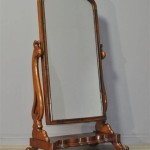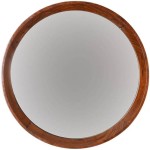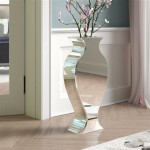Ideal Bathroom Mirror Size: A Comprehensive Guide
Selecting the appropriate bathroom mirror size is a crucial element in bathroom design, influencing both the functionality and aesthetic appeal of the space. A well-chosen mirror can enhance lighting, create the illusion of more space, and serve as a focal point within the bathroom. Conversely, an improperly sized mirror can detract from the overall design and potentially hinder practicality. This article provides a comprehensive guide to determining the ideal bathroom mirror size, considering various factors such as vanity size, bathroom dimensions, and personal preferences.
The bathroom mirror is not merely a reflective surface; it is an integral design component that contributes significantly to the atmosphere of the room. It serves practical purposes such as grooming, applying makeup, and shaving, but it also plays a role in reflecting light to brighten the space and making it appear larger. Therefore, carefully considering the dimensions of the mirror is essential to achieve a harmonious and functional bathroom design.
Matching the Mirror to the Vanity
The size of the vanity is the primary determinant of the ideal bathroom mirror size. Generally, the mirror should be close to the width of the vanity, if not slightly narrower. This creates a balanced and aesthetically pleasing appearance. A mirror that is significantly wider than the vanity can overwhelm the space, while one that is too narrow can appear disproportionate and inadequate.
For a single-sink vanity, a mirror that is approximately 70-80% of the vanity's width is often a good starting point. For instance, if the vanity is 36 inches wide, a mirror that is 25-29 inches wide is likely to be suitable. This allows for some space on either side of the mirror, preventing it from looking cramped or oversized. However, this is a general guideline, and personal preference can play a role in the final decision. Some individuals may prefer a mirror that is closer to the vanity's actual width for a more continuous look.
Double-sink vanities offer more flexibility in mirror selection. Options include installing two separate mirrors, one above each sink, or opting for a single, larger mirror that spans the entire vanity. If choosing separate mirrors, ensure they are of equal size and positioned symmetrically above each sink. The space between the mirrors should be kept to a minimum to maintain a cohesive look. If selecting a single mirror, it should ideally be the same width as the vanity, or slightly shorter to ensure a balanced appearance.
The height of the mirror should also be considered in relation to the vanity and the overall bathroom dimensions. A general rule of thumb is that the bottom of the mirror should be approximately 5-10 inches above the backsplash. This measurement is based on standard backsplash heights but can be adjusted to suit individual preferences and the specific design of the vanity and backsplash. The top of the mirror should ideally be at least 6-7 feet above the floor to accommodate most adults comfortably.
In situations where a vessel sink is used, the height calculation becomes slightly more complex. Since vessel sinks sit on top of the vanity counter, they effectively increase the height of the vanity. Therefore, the mirror's height should be adjusted accordingly to maintain the desired proportions. Consider the overall height of the vanity and vessel sink combination when determining the placement of the mirror. It may be necessary to position the mirror slightly higher than usual to ensure it is appropriately sized for comfortable use.
Frameless mirrors are particularly popular in modern bathrooms due to their clean, minimalist aesthetic. Without a frame, the visible reflective area is maximized, which can be advantageous in smaller bathrooms. Frameless mirrors are also versatile and can be easily incorporated into various design styles. However, the absence of a frame means that the edges of the mirror are exposed, so care should be taken during installation to ensure they are properly sealed to prevent moisture damage.
Framed mirrors can add a decorative element to the bathroom and can be used to complement other design features, such as the vanity hardware or the color scheme. The frame's width and style can significantly impact the overall appearance of the mirror. A wide, ornate frame can make a statement, while a narrow, simple frame can provide a more subtle touch. When selecting a framed mirror, consider the overall style of the bathroom and choose a frame that harmonizes with the existing décor.
Considering Bathroom Dimensions and Layout
Beyond the vanity size, the overall dimensions of the bathroom play a crucial role in determining the appropriate mirror size. In smaller bathrooms, maximizing the feeling of space is essential. A larger mirror can create the illusion of a more expansive room by reflecting more light and visually enlarging the area. Floor-to-ceiling mirrors can be particularly effective in small bathrooms, but they may not be practical or aesthetically pleasing in all situations. Consider the functionality and the overall design before opting for a very large mirror.
In larger bathrooms, the mirror size can be scaled up accordingly. A large mirror can serve as a dramatic focal point and can enhance the sense of luxury and spaciousness. However, it is important to ensure that the mirror remains proportional to the other elements in the room. A mirror that is too large can overwhelm the space and detract from the overall design. Consider the placement of other fixtures and features, such as windows, doors, and artwork, when determining the appropriate mirror size. The mirror should complement these elements, not compete with them.
The layout of the bathroom can also influence the choice of mirror size. In bathrooms with unusual layouts or architectural features, such as sloped ceilings or asymmetrical walls, custom-sized mirrors may be necessary. These mirrors can be tailored to fit the specific dimensions of the space and can maximize the available reflective surface. Consulting with a professional mirror installer or designer can be beneficial in these situations to ensure the mirror is properly sized and installed.
The placement of lighting fixtures should also be taken into account when selecting a bathroom mirror. Ideally, lighting should be positioned to illuminate the face evenly, minimizing shadows and providing adequate visibility for grooming and other tasks. Sconces mounted on either side of the mirror are a popular choice, as they provide balanced lighting and create a flattering effect. Overhead lighting, such as recessed lights or a pendant fixture, can also be used to supplement the sconces. However, ensure the overhead lighting does not create harsh shadows or glare on the mirror's surface.
Mirrors with integrated lighting are becoming increasingly popular due to their sleek appearance and efficient functionality. These mirrors feature LED lights embedded within the mirror itself, providing even and diffused illumination. Mirrors with integrated lighting are particularly well-suited for modern bathrooms and can eliminate the need for separate sconces or overhead lighting fixtures. However, it is important to choose a mirror with high-quality LED lights that provide adequate brightness and color rendering.
Considering Practicality and Personal Preferences
While the vanity size and bathroom dimensions are important considerations, personal preferences should also play a role in determining the ideal bathroom mirror size. Some individuals prefer a larger mirror for practical reasons, such as being able to see their entire reflection or having more space for applying makeup. Others may prefer a smaller mirror for aesthetic reasons, such as creating a more minimalist or understated look.
Consider the primary purpose of the bathroom when selecting a mirror. If the bathroom is used primarily for grooming and personal care, a larger mirror with adequate lighting may be more appropriate. If the bathroom is used primarily as a powder room for guests, a smaller, more decorative mirror may be sufficient. The choice of mirror should reflect the intended use of the space and the user's individual needs and preferences.
The shape of the mirror can also influence the overall appearance of the bathroom. Rectangular mirrors are the most common choice, as they are versatile and can be easily incorporated into various design styles. However, other shapes, such as round, oval, or square, can add visual interest and create a unique aesthetic. Round mirrors can soften the angular lines of a bathroom and create a more welcoming atmosphere, while oval mirrors can elongate the space and add a touch of elegance. Square mirrors are a more contemporary choice and can be used to create a clean, geometric look.
Ultimately, the ideal bathroom mirror size is a matter of personal choice. By considering the vanity size, bathroom dimensions, and personal preferences, one can select a mirror that is both functional and aesthetically pleasing. Experiment with different sizes and shapes to find a mirror that complements the overall design of the bathroom and enhances the user's experience.
The installation process of the bathroom mirror is just as critical as the selection of the mirror itself. Incorrect installation can lead to issues such as instability, improper lighting, or even damage to the mirror and surrounding surfaces. It is generally advisable to hire a professional mirror installer, especially for larger or more complex mirrors. A professional installer will have the necessary tools and expertise to ensure the mirror is securely mounted and properly aligned.
Before installing the mirror, carefully measure the space and mark the desired location on the wall. Use a level to ensure the mirror is perfectly straight and plumb. If drilling into tile or other hard surfaces, use a specialized drill bit designed for those materials to prevent cracking or chipping. Choose appropriate mounting hardware based on the weight and size of the mirror. For heavier mirrors, consider using wall anchors to provide additional support. Once the mirror is installed, inspect it carefully to ensure it is securely attached and there are no gaps or uneven surfaces.
Mirror Styles and Functionality: Beyond Size
Beyond the physical dimensions of the mirror, the style and functionality also contribute significantly to the overall user experience. Factors such as integrated lighting, anti-fogging technology, magnification options, and smart features should influence the selection process. These features enhance the practicality of the mirror and contribute to a more luxurious and convenient bathroom environment.
Mirrors with integrated lighting eliminate the need for separate sconces or overhead lighting fixtures, providing even and diffused illumination directly on the face. This is particularly beneficial for tasks such as applying makeup or shaving, as it minimizes shadows and provides adequate visibility. Mirrors with integrated lighting typically use LED technology, which is energy-efficient and long-lasting. When selecting a mirror with integrated lighting, consider the color temperature and brightness of the LED lights. A warm white light is generally considered more flattering than a cool white light, and the brightness should be adjustable to suit individual preferences. Integrating lighting into the mirror creates a clean and modern aesthetic, streamlining the overall bathroom design.
Anti-fogging technology is a valuable feature, especially in bathrooms with poor ventilation. These mirrors are equipped with a heating element that prevents condensation from forming on the surface, ensuring a clear reflection even after a hot shower. Anti-fogging technology eliminates the need to manually wipe down the mirror, saving time and effort. The heating element is typically activated by a switch, allowing the user to turn it on or off as needed. This feature is particularly useful for individuals who shave or apply makeup immediately after showering.
Magnification options are beneficial for tasks that require precision, such as applying eyeliner or plucking eyebrows. Mirrors with built-in magnification offer a magnified view of the face, allowing for closer inspection and more accurate results. The magnification level typically ranges from 5x to 10x. Some mirrors have a dual-sided design, with one side offering standard reflection and the other side offering magnification. These mirrors provide versatility and cater to a wider range of needs.
Smart mirrors represent the cutting edge of bathroom technology, integrating features such as touch screen displays, voice control, and connectivity to other smart devices. These mirrors can display information such as weather forecasts, news headlines, and calendar appointments. They can also be used to control other smart home devices, such as lighting, temperature, and music. Smart mirrors offer a high degree of convenience and personalization, transforming the bathroom into a more connected and interactive space. While smart mirrors are often more expensive than traditional mirrors, they offer a unique and technologically advanced experience.

Bathroom Mirror Size Calculator

Bathroom Mirror Size Calculator

How To Choose The Best Size Mirror Olde Good Things

Bathroom Mirror Size Calculator Vanity Sizes Double Rectangular

How To Choose The Perfect Mirror Placement Bathroom Vanity Sizes Design Small Modern

Ello Allo 20 In W X 28 H Rectangular Aluminum Framed Wall Bathroom Vanity Mirror Black Ebm S Fb20 The Home Depot

How To Choose A Bathroom Mirror

How To Choose A Bathroom Mirror

Pin By Tania Rejalaga On Bathroom Ideas Vanity Sizes Dimensions Modern

How High Should You Hang The Mirror In A Bathroom With Photos Design Morsels








